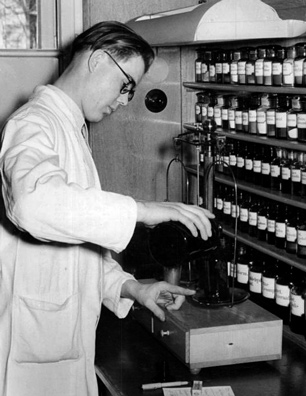Pharmaceuticals and
Personal Care Products (PPCPs)

PPCP is the popularly used acronym for pharmaceuticals—the incredibly vast range of chemicals of medicinal and veterinary use—and personal care products—things like toothpaste, soap and sunscreen that get used and washed away. The term also encompasses illegal drugs, food additives like caffeine, and natural and synthetic hormones either given to livestock or secreted invisibly as a matter of course.
They have a number of pathways to drinking water. Some pharmaceuticals arrive in municipal wastewater through improper disposal of expired bottles, but they can also arrive through their intended use—no chemical is absorbed entirely and much of what's used ends up back down the drain. They can also end up in water through industrial, agricultural and medical waste, leeching from landfills, and through biological waste that has been recycled for use as fertilizer.
Despite the ubiquity of these products and their many pathways to water, levels detected in drinking water are generally very low due to environmental degradation and municipal water treatment.
Effects of Pharmaceuticals and Personal Care Products in Water
Due to the wide variety of pharmaceuticals and PCPs that can end up in drinking water, the long-term effects on human health are mostly unknown. Still, the levels that have been detected in water supplies are extremely low—measured in nanograms and low micrograms—and, so far, there is no evidence that pharmaceuticals in water are affecting human health.
There is some concern, however, that the release of antiobiotics into the environment (in addition to other factors, like overuse) will lead to the growth of drug-resistant bacteria. This may pose a serious threat to human health, rendering some antiobiotics inadequate to control new populations of “super bugs.”
For now, effects of exposure on aquatic life are of immediate concern, due to the likelihood that this type of exposure will be to larger amounts, and over longer periods of time. Studies so far have indicated that some endocrine disrupting pharmaceuticals (birth control pills) can cause changes in the reproductive anatomy of fish.
Water Treatment for Pharmaceuticals and Personal Care Products
The WHO reports on studies showing that chlorine (although not chloramines), ozone, activated carbon and reverse osmosis are all effective treatments for the pharmaceuticals they've examined:
Studies on conventional drinking-water treatment processes have shown that coagulation is largely ineffective in removing pharmaceuticals. Free chlorine is able to remove up to approximately 50% of the pharmaceuticals investigated, whereas chloramines have lower removal efficiency. Compounds that showed high removal by free chlorine but low removal by chloramines include antibiotics, such as sulfamethoxazole, trimethroprim and erythromycin.
Advanced water treatment processes, such as ozonation, advanced oxidation, activated carbon and membranes (e.g. nanofiltration, reverse osmosis), are able to achieve higher removal rates (above 99%) for targeted pharmaceutical compounds in various studies in the published literature.
Sources: EPA, WHO, U.S. Government Accountability Office, Photo source: WikiMedia, author: Zentralbild Krueger
Site Index
Filtration Systems
- Aeration for Iron & Sulfide
- Backwashing Filters
(whole house & well units)
- Chlorine & Chemical Injectors
- Countertop Water Filters
- Emergency Filters
- Garden Hose Filters
- Reverse Osmosis, Residential
- Reverse Osmosis, Commercial
- Shower Filters
- Specialty Filters
- Ultraviolet Systems
- Undersink Filters
- Water Softeners
- Whole House Filters
Cartridges
Parts
- Replacement Parts
- Faucets
- Filter Media
- Fittings
- Housings
- O-rings
- Pumps
- Pura UV
- R.O. Parts
- R.O. Tanks
- R.O. Booster Pump
- VIQUA UV